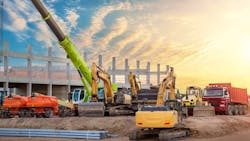The Traditional Equipment Management Model Is No Longer Enough
Key Highlights
- The old equipment model is quietly draining profits across construction operations.
- Top contractors are building standalone equipment divisions to drive new revenue.
- Modern systems deliver enterprise-wide visibility, control, and financial accuracy.
- Automation eliminates blind spots and turns equipment into a profit engine.
- The future of construction belongs to those who run equipment like a business.
For decades, construction companies relied on an equipment model that cannot keep up with today’s pace of projects. Tracking equipment in spreadsheets, handling requests by phone calls, and managing costs on the back end of finance systems was acceptable. Even the more modern “point solutions” designed to track equipment or log maintenance only solved pieces of the puzzle.
But the demands of the industry changed. Projects are larger, schedules are tighter, margins are thinner, and owners demand more transparency than ever before. In this environment, operations leaders cannot afford to treat equipment as a background function. To stay profitable, equipment operations must be run like a standalone business, backed by systems that scale.
Where the Old Equipment Model Falls Short
The traditional model fails construction companies in ways that directly erode margins:
- Siloed tech. GPS trackers, mobile service apps, or small rental tools can locate a machine or log a repair, but they don’t connect operations, finance, and job sites. That leaves managers with data in pockets, useful for solving narrow problems but useless for enterprise-wide decisions.
- No view of total cost of ownership. Without connected systems, operations leaders can’t see the true lifecycle cost of equipment. They’re left guessing whether an asset has earned back its purchase price, when it should be retired, or whether new capital should go toward additional units.
- Limited financial control. Point solutions are rarely built for real-world complexities like automatically uplifting re-rents, invoicing external parties, or tying utilization data back into ROI reporting. At scale, this leaves millions of dollars in value uncaptured.
- Capped growth. Tool and equipment-tracking apps and basic systems may work for smaller companies, but at enterprise scale they impose a ceiling. They can’t run equipment operations as a profit center because they were never built to manage P&L, growth forecasting, or external revenue streams.
- Max cap complexity. One of the most telling examples of how the industry has changed is the rise of max cap rental clauses. These agreements cap charges once they reach a ceiling, often tied to the purchase price of the asset. For contractors managing caps manually or with limited tools, forecasting and compliance is nearly impossible. Miss a cap, and you risk disputes with owners. Apply a cap incorrectly, and you give away revenue. In a low-margin industry, these errors are too costly to ignore.
Each of these examples highlights the same truth: the old model, whether paper-based, spreadsheet-driven, or supported by narrow point solutions, was never built to handle the financial, operational, and contractual realities of today’s construction environment.
The Solution: Building a Business Unit Around Equipment
The most forward-thinking contractors have recognized that equipment can no longer sit buried inside procurement or scattered across job sites. Instead, they are building dedicated business units around equipment operations, and putting enterprise-grade technology like RentalResult construction equipment management software at the center.
This shift enables several critical capabilities that the traditional model cannot provide:
1. Full Visibility Across the Enterprise
Modern systems give leaders real-time insight into where equipment is, how it’s being used, and whether it’s generating ROI. This eliminates double ordering, reduces wasted spend on third-party rentals, and allows for smarter redeployment.
2. Control Over Total Cost of Ownership
By tracking costs across the lifecycle of every asset, purchase, maintenance, utilization, and disposal, companies can finally answer strategic questions with data. Should we buy, rent, re-rent, or sell? With full transparency, decisions aren’t guesses; they’re financial strategies.
3. Automated Financial Controls
At enterprise scale, automation ensures accuracy and consistency across every transaction. Modern systems handle complex realities like:
-
- Automatically uplifting re-rents to recover margin
- Enforcing contract terms and billing accuracy
- Supporting external rentals to subcontractors and third parties
- This financial discipline is what turns equipment from a cost center into a revenue generator.
4. Forecasting and Managing Max Cap
Automated systems apply max cap rules consistently and allow operations and finance teams to forecast cap thresholds before they hit. That means leaders know exactly when billing will stop, protecting margins while maintaining credibility with owners. It’s proactive, not reactive, something point solutions simply can’t deliver.
5. Enabling Growth Beyond Tracking
The biggest difference is scale. Where point solutions stop at tracking, an enterprise-grade system enables equipment divisions to operate as standalone units with their own leadership, P&L, and revenue streams. It supports not just the movement of assets, but the financial and operational backbone needed to grow.
An Industry Trend Taking Hold
Across the industry, large contractors are separating their equipment operations into independent divisions—complete with their own leadership teams, revenue targets, and customer bases. Internal projects once relied on equipment divisions, but now these divisions are evolving into strategic business functions that support both internal and external demand.
These divisions are using purpose-built software to manage internal requests, track utilization, forecast max caps, and even rent externally to third parties. The result is a model that improves efficiency, reduces dependency on outside vendors, and turns what was once a cost burden into a driver of profitability and control.
In short, the industry is proving that the key to equipment success isn’t more complex—it’s better visibility, discipline, and strategy.
The New Construction Equipment Management Standard
The traditional model—reactive, fragmented, and built on tools that weren’t designed for growth—has run its course. Contractors who continue using it will keep losing margin to idle assets, missed revenue, and blind spots in cost.
The new model is here: one that treats equipment as a business in itself—driven by connected systems, financial transparency, and operational control.
The Next Era of Construction: Running Equipment as a Business
The contractors redefining equipment management are proving that innovation doesn’t always mean more complexity, it means better control. The future of construction will belong to those who view equipment not just as tools for the job, but as strategic assets that drive performance, profit, and growth.


